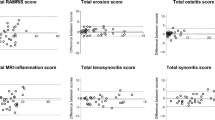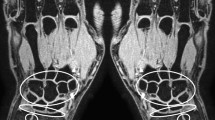Abstract
Objectives
To explore if the reliability of synovitis assessment by unenhanced MRI is influenced by different MRI field-strengths, coil types and image resolutions in RA patients.
Methods
Forty-one RA patients and 12 healthy controls underwent hand MRI (wrist and 2nd--5th metacarpophalangeal joints) at 4 different field-strengths (0.23 T/0.6 T/1.5 T/3.0 T) on the same day. Seven protocols using a STIR sequence with different field-strengths, coils (flex coils/dedicated phased-array extremity coils) and resolution were applied and scored blindly for synovitis (OMERACT-RAMRIS method). A 1.5 T post-contrast T1-weighted sequence was used as gold standard reference.
Results
Fair-good agreement (ICC=0.38--0.72) between the standard reference and the different STIR protocols (best agreement with extremity coil and small voxel size at 1.5 T). The accuracy for presence/absence of synovitis was very high per person (0.80--1.0), and moderate-high per joint (0.63--0.85), whereas exact agreements on scores were moderate (0.50--0.66). The intrareader agreement (15 patients and 3 controls) on presence/absence of synovitis was very high (0.87--1.0).
Conclusions
Unenhanced MRI using STIR sequence is only moderately reliable for assessing hand synovitis in RA, when contrast-enhanced MRI is considered the gold standard reference. Contrast injection, field strength and coil type influence synovitis assessment, and should be considered before performing MRI in clinical trials and practice.
Key Points
• STIR is only moderately reliable for synovitis assessment, compared with post–contrast-T1-w.
• Contrast injection, field strength, and coil type influence synovitis assessment.
• Contrast injection is recommended for reliable and reproducible hand synovitis assessment.


Similar content being viewed by others
References
Ostergaard M, Pedersen SJ, Dohn UM (2008) Imaging in rheumatoid arthritis–status and recent advances for magnetic resonance imaging, ultrasonography, computed tomography and conventional radiography. Best Pract Res Clin Rheumatol 22:1019–1044
Whitten CG, Moore TE, Yuh WT, Kathol MH, Renfrew DL, Walker CW (1992) The use of intravenous gadopentetate dimeglumine in magnetic resonance imaging of synovial lesions. Skelet Radiol 21:215–218
Peterfy C, Edmonds J, Lassere M, Conaghan P, Ostergaard M, McQueen F et al (2003) OMERACT rheumatoid arthritis MRI studies module. J Rheumatol 30:1364–1365
McQueen FM (2009) The MRI view of synovitis and tenosynovitis in inflammatory arthritis: implications for diagnosis and management. Ann N Y Acad Sci 1154:21–34
Thomsen HS (2013) Non-renal adverse reactions to contrast media: separating fact from myth. Acta Radiol 54:835–836
Semelka RC, Hernandes Mde A, Stallings CG, Castillo M (2013) Objective evaluation of acute adverse events and image quality of gadolinium-based contrast agents (gadobutrol and gadobenate dimeglumine) by blinded evaluation. Pilot study. Magn Reson Imaging 31:96–101
Thomsen HS (2011) Contrast media safety-an update. Eur J Radiol 80:77–82
Suzuki T, Ito S, Handa S, Kose K, Okamoto Y, Minami M et al (2009) A new low-field extremity magnetic resonance imaging and proposed compact MRI score: evaluation of anti-tumor necrosis factor biologics on rheumatoid arthritis. Mod Rheumatol 19:358–365
Taouli B, Zaim S, Peterfy CG, Lynch JA, Stork A, Guermazi A et al (2004) Rheumatoid arthritis of the hand and wrist: comparison of three imaging techniques. AJR Am J Roentgenol 182:937–943
Ostergaard M, Conaghan PG, O'Connor P, Szkudlarek M, Klarlund M, Emery P et al (2009) Reducing invasiveness, duration, and cost of magnetic resonance imaging in rheumatoid arthritis by omitting intravenous contrast injection – does it change the assessment of inflammatory and destructive joint changes by the OMERACT RAMRIS? J Rheumatol 36:1806–1810
Ostergaard M, Peterfy C, Conaghan P, McQueen F, Bird P, Ejbjerg B et al (2003) OMERACT rheumatoid arthritis magnetic resonance imaging studies. Core set of MRI acquisitions, joint pathology definitions, and the OMERACT RA-MRI scoring system. J Rheumatol 30:1385–1386
Bird P, Ejbjerg B, McQueen F, Ostergaard M, Lassere M, Edmonds J (2003) OMERACT rheumatoid arthritis magnetic resonance imaging studies. Exercise 5: an international multicenter reliability study using computerized MRI erosion volume measurements. J Rheumatol 30:1380–1384
Ejbjerg B, McQueen F, Lassere M, Haavardsholm E, Conaghan P, O'Connor P et al (2005) The EULAR-OMERACT rheumatoid arthritis MRI reference image atlas: the wrist joint. Ann Rheum Dis 64:i23–i47
Krabbe S, Eshed I, Pedersen SJ, Boyesen P, Moller JM, Therkildsen F et al (2014) Bone marrow oedema assessment by magnetic resonance imaging in rheumatoid arthritis wrist and metacarpophalangeal joints: the importance of field strength, coil type and image resolution. Rheumatology (Oxford) 53:1446–1451
Lassere M, McQueen F, Ostergaard M, Conaghan P, Shnier R, Peterfy C et al (2003) OMERACT rheumatoid arthritis magnetic resonance imaging studies. Exercise 3: an international multicenter reliability study using the RA-MRI Score. J Rheumatol 30:1366–1375
Haavardsholm EA, Ostergaard M, Ejbjerg BJ, Kvan NP, Uhlig TA, Lilleas FG et al (2005) Reliability and sensitivity to change of the OMERACT rheumatoid arthritis magnetic resonance imaging score in a multireader, longitudinal setting. Arthritis Rheum 52:3860–3867
Tamai M, Kawakami A, Uetani M, Fukushima A, Arima K, Fujikawa K et al (2012) Magnetic resonance imaging (MRI) detection of synovitis and bone lesions of the wrists and finger joints in early-stage rheumatoid arthritis: comparison of the accuracy of plain MRI-based findings and gadolinium-diethylenetriamine pentaacetic acid-enhanced MRI-based findings. Mod Rheumatol 22:654–658
Morrison WB (2005) Indirect MR arthrography: concepts and controversies. Semin Musculoskelet Radiol 9:125–134
Boles CA, Ward WG Sr (2000) Loose fragments and other debris: miscellaneous synovial and marrow disorders. Magn Reson Imaging Clin N Am 8:371–390
Dewan AK, Chhabra AB, Khanna AJ, Anderson MW, Brunton LM (2013) Magnetic resonance imaging of the hand and wrist: techniques and spectrum of disease: AAOS exhibit selection. J Bone Joint Surg Am 95:e68
Ejbjerg B, Narvestad E, Rostrup E, Szkudlarek M, Jacobsen S, Thomsen HS et al (2004) Magnetic resonance imaging of wrist and finger joints in healthy subjects occasionally shows changes resembling erosions and synovitis as seen in rheumatoid arthritis. Arthritis Rheum 50:1097–1106
Kneeland JB (1995) Technical considerations for MR imaging of the hand and wrist. Magn Reson Imaging Clin N Am 3:191–196
Naraghi AM, White LM, Patel C, Tomlinson G, Keystone EC (2009) Comparison of 1.0-T extremity MR and 1.5-T conventional high-field-strength MR in patients with rheumatoid arthritis. Radiology 251:829–837
Ejbjerg BJ, Narvestad E, Jacobsen S, Thomsen HS, Ostergaard M (2005) Optimised, low cost, low field dedicated extremity MRI is highly specific and sensitive for synovitis and bone erosions in rheumatoid arthritis wrist and finger joints: comparison with conventional high field MRI and radiography. Ann Rheum Dis 64:1280–1287
Axelsen MB, Stoltenberg M, Poggenborg RP, Kubassova O, Boesen M, Bliddal H et al (2012) Dynamic gadolinium-enhanced magnetic resonance imaging allows accurate assessment of the synovial inflammatory activity in rheumatoid arthritis knee joints: a comparison with synovial histology. Scand J Rheumatol 41:89–94
Boesen M, Kubassova O, Bouert R, Axelsen MB, Ostergaard M, Cimmino MA et al (2012) Correlation between computer-aided dynamic gadolinium-enhanced MRI assessment of inflammation and semi-quantitative synovitis and bone marrow oedema scores of the wrist in patients with rheumatoid arthritis--a cohort stud. Rheumatology (Oxford) 51:134–143
Barth MM, Smith MP, Pedrosa I, Lenkinski RE, Rofsky NM (2007) Body MR imaging at 3.0 T: understanding the opportunities and challenges. Radiographics 27:1445–1462, discussion 1462-4
Acknowledgements
The scientific guarantor of this publication is Mikkel Ostergaard. The authors of this manuscript declare no relationships with any companies whose products or services may be related to the subject matter of the article. The authors state that this work has not received any funding. One of the authors has significant statistical expertise. Institutional Review Board approval was obtained. Written informed consent was obtained from all subjects (patients) in this study. Some study subjects or cohorts have been previously reported in Rheumatology (Oxford). 2014 Mar 21.: Krabbe S, Eshed I, Pedersen SJ, Bøyesen P, Møller JM, Therkildsen F, Axelsen MB, Madsen OR, Ostergaard M."Bone marrow oedema assessment by magnetic resonance imaging in rheumatoid arthritis wrist and metacarpophalangeal joints: the importance of field strength, coil type and image resolution." Methodology: prospective, diagnostic or prognostic study, multicenter study.
Author information
Authors and Affiliations
Corresponding author
Rights and permissions
About this article
Cite this article
Eshed, I., Krabbe, S., Østergaard, M. et al. Influence of field strength, coil type and image resolution on assessment of synovitis by unenhanced MRI – a comparison with contrast-enhanced MRI. Eur Radiol 25, 1059–1067 (2015). https://doi.org/10.1007/s00330-014-3470-9
Received:
Revised:
Accepted:
Published:
Issue Date:
DOI: https://doi.org/10.1007/s00330-014-3470-9




